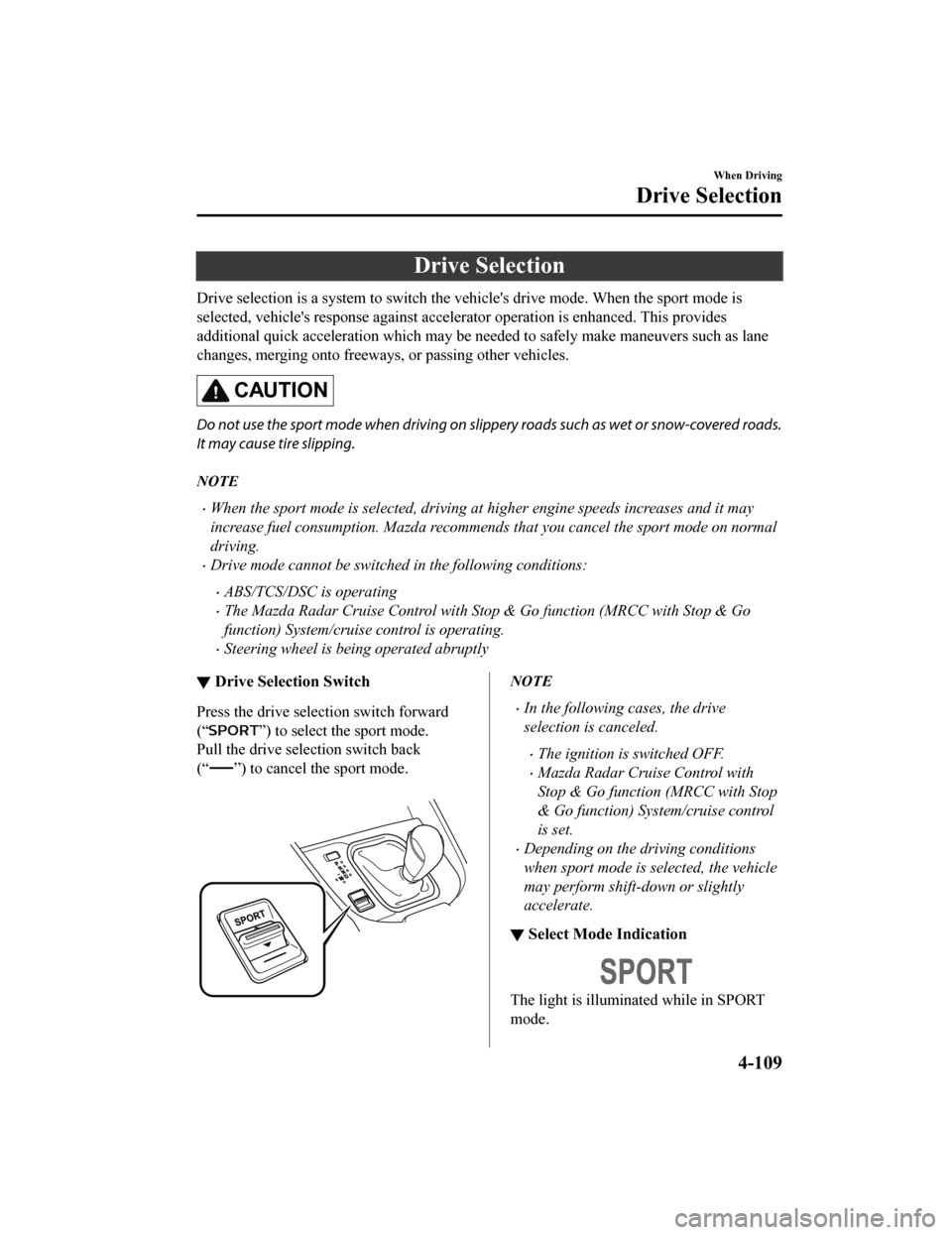light MAZDA MODEL CX-9 2020 Owners Manual (in English)
[x] Cancel search | Manufacturer: MAZDA, Model Year: 2020, Model line: MODEL CX-9, Model: MAZDA MODEL CX-9 2020Pages: 706
Page 275 of 706

Drive Selection
Drive selection is a system to switch the vehicle's drive mode. When the sport mode is
selected, vehicle's response against accelerator operation is enhanced. This provides
additional quick acceleration which may be needed to safely make maneuvers such as lane
changes, merging onto freeways, or passing other vehicles.
CAUTION
Do not use the sport mode when driving on slippery roads such as wet or snow-covered roads.
It may cause tire slipping.
NOTE
’éĘWhen the sport mode is selected, driving at higher engine speeds increases and it may
increase fuel consumption. Mazda recommends that you cancel the sport mode on normal
driving.
’éĘDrive mode cannot be switched in the following conditions:
’éĘABS/TCS/DSC is operating
’éĘThe Mazda Radar Cruise Control with St op & Go function (MRCC with Stop & Go
function) System/cruise control is operating.
’éĘSteering wheel is being operated abruptly
Ō¢╝ Drive Selection Switch
Press the drive selection switch forward
(ŌĆ£
ŌĆØ) to select the sport mode.
Pull the drive selection switch back
(ŌĆ£
ŌĆØ) to cancel the sport mode.
NOTE
’éĘIn the following cases, the drive
selection is canceled.
’éĘThe ignition is switched OFF.
’éĘMazda Radar Cruise Control with
Stop & Go function (MRCC with Stop
& Go function) System/cruise control
is set.
’éĘDepending on the driving conditions
when sport mode is selected, the vehicle
may perform shift-down or slightly
accelerate.
Ō¢╝ Select Mode Indication
The light is illuminated while in SPORT
mode.
When Driving
Drive Selection
4-109
CX-9_8HT8-EA-19I_Edition2_old
2019-9-24 13:14:55
Page 276 of 706

NOTE
The indicator light flashes a few times to
indicate that the mode cannot be switched
to SPORT mode even if the drive select
switch is pressed under the following
conditions:
’éĘABS/TCS/DSC is operating
’éĘThe Mazda Radar Cruise Control with
Stop & Go function (MRCC with Stop &
Go function) System/cruise control is
operating.
’éĘThe vehicle is making a turn or driving
on a curved road.
When Driving
Drive Selection
4-110
CX-9_8HT8-EA-19I_Edition2_old2019-9-24 13:14:55
Page 279 of 706

Power Steering
’éĘPower steering is only operable when
the engine is running. If the engine is off
or if the power steering system is
inoperable, you can still steer, but it
requires more physical effort.
If the steering feels stiffer than usual
during normal driving or the steering
vibrates, consult an Authorized Mazda
Dealer.
’éĘThe warning indication/warning light
notifies the driver of system
abnormalities and operation conditions.
In addition, the buzzer may also activate
depending on the system abnormality or
operation condition.
Refer to Stop Vehicle in Safe Place
Immediately on page 7-28.
Refer to Power Steering Warning
Buzzer on page 7-50.
CAUTION
Never hold the steering wheel to the
extreme left or right for more than 5
seconds with the engine running. This
could damage the power steering system.
When Driving
Power Steering
4-113
CX-9_8HT8-EA-19I_Edition2_old2019-9-24 13:14:55
Page 280 of 706

i-ACTIVSENSE*
i-ACTIVSENSE is a collective term covering a series of advanced safety and driver support
systems which make use of a Forward Sensing Camera (FSC) and radar sensors. These
systems consist of active safety and pre-crash safety systems.
These systems are designed to assist the driver in safer driving by reducing the load on the
driver and helping to avert collisions or reduce their severity. However, because each system
has its limitations, always drive carefully and do not rely solely on the systems.
Ō¢╝Active Safety Technology
Active Safety Technology supports safer driving by helping the driver to recognize potential
hazards and avert accidents.
Driver awareness support systems
Nighttime visibility
Adaptive Fron
t Lighting System (AFS)................................................................... page 4-117
High Beam Control System (HBC).......................................................................... page 4-118
Left/right side and rear side detection
Lane Departure Warning System (LDWS)..... ......................................................... page 4-156
Blind Spot Monitoring (BSM)......................... ........................................................ page 4-121
Road sign recognition
Traffic Sign Recognition System (TSR).................................................................. page 4-127
Inter-vehicle distance recognition
Distance Recognition Su pport System (DRSS)....................................................... page 4-133
Rear obstruction detection when leaving a parking space
Rear Cross Traffic Alert (RCTA).............................................................................page 4-137
Full-surround recognition
360┬░View Monitor................................................................................................... page 4-175
Driver support systems
Inter-vehicle distance
Mazda Radar Cruise Control with Stop & Go function (MRCC with Stop & Go
function)................................................................................................................... pag e 4-141
Lane departure
Lane-keep Assist System (LAS)................... ........................................................... page 4-156
When Driving
i-ACTIVSENSE
4-114*Some models.
CX-9_8HT8-EA-19I_Edition2_old 2019-9-24 13:14:55
Page 281 of 706

Ō¢╝Pre-Crash Safety Technology
Pre-crash safety technology is designed to assi
st the driver in averting collisions or reduce
their severity in situations where they cannot be avoided.
Collision damage reduction in low vehicle speed range
Forward driving
Smart City Brake Support (SCBS).......................................................................... page 4-170
Advanced Smart City Brake Support (Advan ced SCBS)........................................ page 4-167
Collision damage reduction in medium/high speed range
Smart Brake Support (SBS)..................................................................................... page 4-173
Ō¢╝ Camera and Sensors
Forward Sensing Camera (FSC)
The Forward Sensing Camera (FSC) detects la
ne indications and recognizes headlights,
taillights and city lights during nighttime driv ing. In addition, it also detects the vehicle
ahead, pedestrians, or obstructions. The following systems also use the Forward Sensing
Camera (FSC).
’éĘHigh Beam Control system (HBC)
’éĘLane-keep Assist System (LAS) & Lane Departure Warning System (LDWS)
’éĘTraffic Sign Recognition System (TSR)
’éĘMazda Radar Cruise Control wi th Stop & Go function (MRCC with Stop & Go function)
’éĘAdvanced Smart City Brake Support (Advanced SCBS)
’éĘSmart City Brake Support (SCBS)
’éĘSmart Brake Support (SBS)
The Forward Sensing Camera (FSC) is installed at the top of the windshield near the
rearview mirror.
Refer to Forward Sensing Camera (FSC) on page 4-201.
Radar sensor (front)
The radar sensor (front) functions by detecti ng the radio waves reflected off a vehicle ahead
sent from the radar sensor. The following systems also use the radar sensor (front).
’éĘMazda Radar Cruise Control with Stop & Go function (MRCC with Stop & Go function)
’éĘDistance Recognition Support System (DRSS)
’éĘSmart Brake Support (SBS)
The radar sensor (front) is mount ed behind the radiator grille.
Refer to Radar Sensor (Front) on page 4-206.
When Driving
i-ACTIVSENSE
4-115
CX-9_8HT8-EA-19I_Edition2_old 2019-9-24 13:14:55
Page 283 of 706

Adaptive Front Lighting System (AFS)*
The adaptive front lighting system (AFS) automatically adjusts the headlight beams to the
left or right in conjunction with the operation of the steering wheel after the headlights have
been turned on.
A system malfunction or operation conditions are indicated by a warning.
Refer to Contact Authorized Mazda Dealer and Have Vehicle Inspected on page 7-31.
NOTE
The Adaptive Front Lighting System (AFS) func tion can be switched to operable/inoperable
using the personalization function.
Refer to Personalization Features on page 9-9.
When Driving
i-ACTIVSENSE
*Some models.4-117
CX-9_8HT8-EA-19I_Edition2_old 2019-9-24 13:14:55
Page 284 of 706

High Beam Control System (HBC)*
The HBC determines the conditions in front of the vehicle using the Forward Sensing
Camera (FSC) while driving in darkness to automatically switch the headlights between
high and low beams.
Refer to Forward Sensing Camera (FSC) on page 4-201.
While driving the vehicle at a speed of about 30 km/h (19 mph) or more, the headlights are
switched to high beams when there are no vehicles ahead or approaching in the opposite
direction.
The system switches the headlights to low beams when one of the following occurs:
’éĘThe system detects a vehicle or the headlights/lights of a vehicle approaching in the
opposite direction.
’éĘThe vehicle is driven on roads lined with st reetlamps or on roads in well-lit cities and
towns.
’éĘThe vehicle is driven at less than about 20 km/h (12 mph).
Forward Sensing
Camera (FSC)
The recognition distance of the
Forward Sensing Camera (FSC)
varies according to the
surrounding conditions.
The warning light turns on when
the system has a malfunction.
Refer to Contact Authorized Mazda Dealer and Have Vehicle Inspected on page 7-31.
CAUTION
’āś Do not adjust the vehicle height, modify th e headlight units, or remove the camera,
otherwise the system will not operate normally.
’āś Do not rely excessively on the HBC and drive the vehicle while paying sufficient attention to
safety. Switch the headlights between the high beams and low beams manually if
necessary.
When Driving
i-ACTIVSENSE
4-118*Some models.
CX-9_8HT8-EA-19I_Edition2_old 2019-9-24 13:14:55
Page 285 of 706

NOTE
The timing in which the system switches the headlights changes under the following
conditions. If the system does not switch the headlights appropriately, manually switch
between high and low beams according to the visibility as well as road and traffic
conditions.
’éĘWhen there are sources of light in the area such as street lamps, illuminated signboards,
and traffic signals.
’éĘWhen there are reflective objects in the surrounding area such as reflective plates and
signs.
’éĘWhen visibility is reduced under rain, snow and foggy conditions.
’éĘWhen driving on roads with sharp turn or hilly terrain.
’éĘWhen the headlights/rear lamps of vehicles in front of you or in the opposite lane are dim
or not illuminated.
’éĘWhen there is sufficient darkness such as at dawn or dusk.
’éĘWhen the luggage compartment is loaded with heavy objects or the rear passenger seats
are occupied.
’éĘWhen visibility is reduced due to a vehicle in front of you spraying water from its tires
onto your windshield.
Ō¢╝ To Operate the System
The HBC operates to switch the headlights
automatically between high and low
beams after the igniti
on is switched ON
and the headlight switch is in the AUTO
and high beam position.
The HBC determines that it is dark based
on the brightness of the surrounding area.
At the same time, the HBC indicator light
(green) in the in strument cluster
illuminates.
NOTE
’éĘWhen the vehicle speed is about 30 km/h
(19 mph) or more, the headlights
automatically switch to high beams
when there are no vehicles ahead or
approaching in the opposite direction.
When the vehicle speed is less than
about 20 km/h (12 mph), the HBC
switches the headlights to low beams.
’éĘThe low beams may not switch to high
beams when cornering.
’éĘOperation of the HBC function can be
disabled. Refer to Personalization
Features on page 9-9.
Ō¢╝ Manual Switching
Switching to low beams
Shift the lever to th
e low beam position.
The HBC indicator light (green) turns off.
When Driving
i-ACTIVSENSE
4-119
CX-9_8HT8-EA-19I_Edition2_old 2019-9-24 13:14:55
Page 286 of 706

Switching to high beams
Turn the headlight switch to the
position.
The HBC indicator light (green) turns off
and the
is illuminated.
When Driving
i-ACTIVSENSE
4-120
CX-9_8HT8-EA-19I_Edition2_old 2019-9-24 13:14:55
Page 287 of 706

Blind Spot Monitoring (BSM)*
The BSM is designed to assist the driver in checking the area to the rear of the vehicle on
both sides during lane changes by notifying the driver of the presence of vehicles
approaching from the rear in an adjacent lane.
The BSM detects vehicles approaching from the rear while traveling in the forward
direction at a speed of 10 km/h (6.3 mph) or faster and notifies the driver by turning on the
BSM warning indicator light and displaying the vehicle detection screen.
If the turn signal lever is operated to signal a turn in the direction in which the BSM
warning indicator light is illuminated while the approaching vehicle is detected, the BSM
notifies the driver of possible danger by turnin g on the BSM warning indicator light, and by
activating the warning sound and the warning screen indicator display.
The detection area on this system covers the driving lanes on both sides of the vehicle and
from the rear part of the front doors to about 50 m (164 ft) behind the vehicle.
Detection areas
Your vehicle
WA R N I N G
Always check the surrounding area visually before making an actual lane change:
The system is only designed to assist you in checking for vehicles at your rear when making a
lane change. Due to certain limitations with
the operation of this system, the BSM warning
indicator light, the warning sound and the warning screen indicator display may not activate
or they might be delayed even though a vehicle is in an adjacent driving lane. Always make it
your responsibility as a driver to check the rear.
When Driving
i-ACTIVSENSE
*Some models.4-121
CX-9_8HT8-EA-19I_Edition2_old 2019-9-24 13:14:55